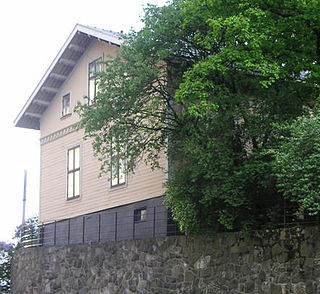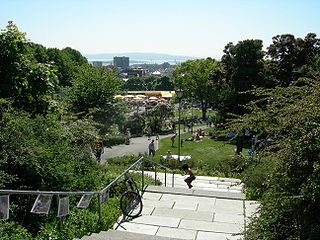

Palace Park (Norwegian : Slottsparken) is a public park in the center of Oslo, Norway, surrounding the Royal Palace. It is 22 hectares (54 acres).


Palace Park (Norwegian : Slottsparken) is a public park in the center of Oslo, Norway, surrounding the Royal Palace. It is 22 hectares (54 acres).
The park was built during the 1840s and was designed by Hans Ditlev Franciscus Linstow, who was the main architect of the palace. Two thousand trees were planted in 1848, but since then the park has been redeveloped several times, becoming simpler with larger but fewer paths and fewer creeks. [1]
Queen's Park forms a separate part of Palace Park, and dates back to 1751 when it was built as a private rococo garden. [2]
Princess Ingrid Alexandra's Sculpture Park is part of Palace Park. There are sculptures made by Norwegian children, for children, and specially chosen by the princess.

Gustav Vigeland, born as Adolf Gustav Thorsen, was a Norwegian sculptor. Gustav Vigeland occupies a special position among Norwegian sculptors, both in the power of his creative imagination and in his productivity. He is most associated with the Vigeland installation (Vigelandsanlegget) in Frogner Park, Oslo. He was also the designer of the Nobel Peace Prize medal.

Frogner is a residential and retail borough in the West End of Oslo, Norway, with a population of 59,269 as of 2020. In addition to the original Frogner, the borough incorporates Bygdøy, Uranienborg and Majorstua. The borough is named after Frogner Manor, and includes Frogner Park. The borough has the highest real estate prices in Norway.

Princess Ingrid Alexandra of Norway is the elder child of Crown Prince Haakon and the second child of Crown Princess Mette-Marit, and a grandchild of King Harald V. She is second in line of succession to the Norwegian throne after her father. She is expected to become the country's second female monarch, after the 15th-century Queen Margaret.

Oscarshall Palace is a maison de plaisance located in the small fjord Frognerkilen on Bygdøy in Oslo, Norway.

Princess Märtha of Sweden was Crown Princess of Norway as the spouse of the future King Olav V from 1929 until her death in 1954. As Olav only became king in 1957, Märtha never became Queen of Norway. Her son, Harald V, is the current king of Norway. Princess Märtha was also an elder sister of Queen Astrid of Belgium and a maternal aunt of Grand Duchess Joséphine-Charlotte of Luxembourg and Kings Baudouin and Albert II of Belgium.

The Royal Palace in Oslo was built in the first half of the 19th century as the Norwegian residence of the French-born Charles XIV John, who reigned as king of Norway and Sweden. The palace is the official residence of the current Norwegian monarch while the Crown Prince resides at Skaugum in Asker west of Oslo.

Frogner Park is a public park in the central West End borough of Frogner in Oslo, Norway. The park is historically part of Frogner Manor and is Oslo's largest park, open to the public at all times. It includes the manor house which is the seat of Oslo Museum, the nearby Henriette Wegner Pavilion, the Vigeland installation of sculptures created by sculptor Gustav Vigeland, Frogner Baths, Frogner stadion, Frognerparken Café, the restaurant Herregårdskroen and the largest collection of roses in the country with 14,000 plants of 150 species. Frogner Park is the most visited tourist attraction in Norway.

Grotten is a nineteenth-century building (1823) located on the premises of the Royal Palace in the city centre of Oslo, Norway. Grotten is an honorary residence owned by the Norwegian state.

Ruth Maier was an Austrian woman whose diaries describing her experiences of the Holocaust in Austria and Norway were published in 2007; reviews described her as "Norway's Anne Frank."

Peer Gynt Sculpture Park is a sculpture park located in Oslo, Norway. The sculpture park was created in honour of the Norwegian writer Henrik Ibsen as a monumental presentation of one of his plays, Peer Gynt, act by act.

Parks and open spaces are an integral part of the landscape of Oslo, the capital and largest city of Norway. The various parks and open spaces are interconnected by paths so that the city's inhabitants can walk between them.

7. juni-plassen is a square in Oslo, Norway.

Brynjulf Larsen Bergslien was a noted Norwegian sculptor.

The Vigeland Museum is a museum dedicated to Gustav Vigeland in Frogner, Oslo. It is located outside Frogner Park, which includes the Vigeland installation with sculptures by Gustav Vigeland. The museum is part of Oslo municipality's cultural department.
Crown Princess Märtha is a bronze statue of Crown Princess Märtha of Norway, by Kirsten Kokkin.

The Queen Sonja Art Stable is a museum, art gallery and concert hall located in the former stables of the Royal Palace in Oslo.

A statue of Queen Victoria stands near Kensington Palace. It was sculpted by Victoria's fourth daughter Princess Louise, Duchess of Argyll and erected in 1893. The statue was made from white marble on a Portland stone base. It depicts Victoria aged 18, seated in her coronation robes, resembling the painting of Victoria at her coronation by Sir George Hayter. The statue received a Grade II listing in 1969.
Anders Svor was a Norwegian sculptor. He was a realist influenced by Romanticism, and Auguste Rodin was also an important inspiration. His work was also part of the sculpture event in the art competition at the 1924 Summer Olympics.

The Sundial is a sculpture that is part of the Vigeland installation in Frogner Park in Oslo, created by Gustav Vigeland. It is a sundial that stands on a pedestal with granite reliefs between the Monolith and the Wheel of Life. The sundial dates back to around 1930. It is one of two sundials in Frogner Park, alongside Benjamin Wegner's sundial in front of Frogner Manor.

The Angry Boy is a sculpture in the Vigeland installation in Frogner Park, Oslo. It depicts a small, angry boy and is considered Gustav Vigeland's most famous sculpture. The sculpture, cast in bronze, was likely modeled in 1928 and installed as one of 58 sculptures on the "Bridge" in the sculpture park in 1940.